 By Bob Currie, Recreational Boating Safety Specialist
By Bob Currie, Recreational Boating Safety Specialist
U. S. Coast Guard Auxiliary Base Galveston Flotilla
I was performing a Vessel Safety Check on a brand new boat for a brand new boat owner one day when the checklist prompted me to ask to see the supply of life jackets for the boat. The boat owner was anxious to get the inspection done so he could put the boat in the water for the first time, and he proudly pulled out 4 self-inflating life jackets and submitted them for approval. Before I checked the life jackets out, I asked the new boat owner how old his daughters were. He said 9 and 11. I asked him if he had any more life jackets besides the self-inflating jackets he had just handed to me. He said no. I then informed him that the life jackets he had just handed me were for adults only.
The Base Galveston Flotilla of the US Coast Guard Auxiliary operates out of the US Coast Guard base on Galveston Island. They aid the Coast Guard by providing maritime observation patrols in Galveston Bay; by providing recreational boating vessel safety checks; and by working alongside Coast Guard members in maritime accident investigation, small boat training, providing a safety zone, Aids to Navigation verification, cooking in base and station galleys and aboard cutters, and on the Coast Guard Drone Team.
Yes, that’s right- inflatable life jackets are not approved for children under 16, and although everyone should wear a life jacket while aboard a boat, children under 13 are required by federal law to wear a properly fitting Coast Guard approved life jacket while underway unless they are inside an enclosed cabin.
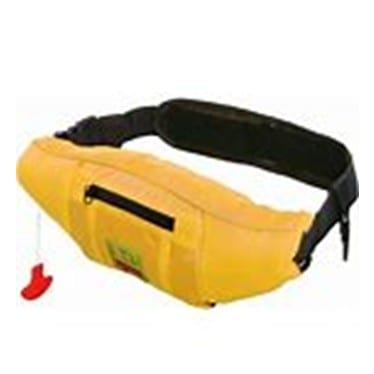
Automatic/Manual Inflatable Belt Pack
Today’s discussion will be about inflatable life jackets (for adults only!).
How Inflatable Life Jackets Work
Inflatable life jackets rely on inflatable chambers that provide buoyancy when inflated. Just as with any type of life jacket, be sure to check that it says “U.S. Coast Guard Approved” on the life jacket. All inflatable life jackets contain a back-up oral inflation tube that also serves as a deflation tube.
Advantages of Inflatable Life Jackets
- Provides high visibility when inflated
- Turns most wearers face-up faster than traditional life jackets
- Will usually keep unconscious users face-up
- Superior in-water performance
Disadvantages of Inflatable Life Jackets
- Not suitable for non-swimmers (manual models only)
- Requires more steps to deploy (manual or water-activated)
- Not approved for children under 16 years of age
- Requires frequent inspection and maintenance
- Not appropriate for activities such as personal watercraft use, tubing, sailboarding, whitewater rafting
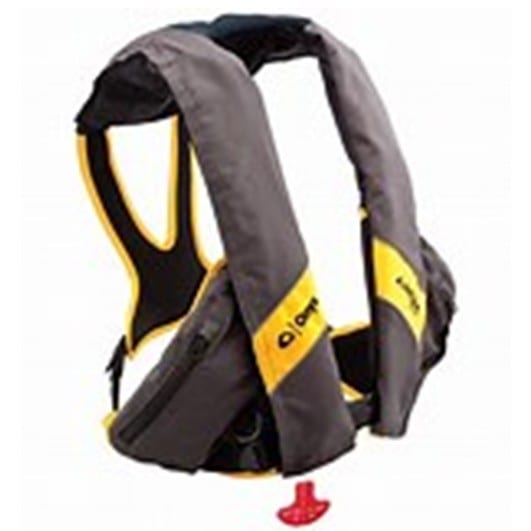
Inflatable Onyx A/M Life Jacket with Side Pockets
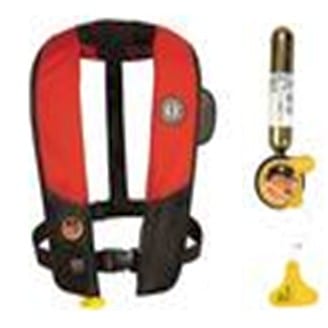
Mustang Hydrostatic A/M Life Jacket (left) with Re-Arming Kit (right)
Automatic, Manual or Hybrid?
-
- There are three basic types of inflatable life jackets:
- Automatic/Manual (A/M) (automatically inflate or can be manually activated)
- Manual (M) (manually inflatable only- no inherent flotation)
- Hybrid (H) (has inherent flotation with manually inflatable boost)
Automatic/Manual Inflatable Life Jackets (A/M)
A/M life jackets like the inflatable Onyx A/M life jacket shown here automatically inflate when submersed in water, yet they can also be manually inflated. Both the automatic and manual functions cause CO2 from a compressed gas cylinder to be released into the flotation chamber. There are two types of submersion systems: (1) Dissolving salt block that allows a spring-loaded mechanism to pierce the gas cylinder, and (2) hydrostatic activator that works on pressure from the water to activate the piercing mechanism. The advantage that the hydrostatic mechanism has is that it is not subject to premature activation due to moisture in the air dissolving the salt block. I have had my dissolving salt block A/M life jacket activate inside my “waterproof” storage locker. The big drawback to the hydrostatic system is price.

Mustang Khimera Hybrid Inflatable Life Jacket
They cost upwards of $200-$300, and the re-arming kit costs as much as a standard dissolving salt block type life jacket ($79).
Hybrid Inflatable Life Jacket (H)
The hybrid inflatable life jacket has enough inherent flotation (7.5 pounds) to lift the average grown person’s head above water. If more flotation is required, a yank on the activation handle sends CO2 into a bladder on the front of the life jacket, boosting the total flotation to 20 pounds. I purchased one when they first came out. Unlike other types of inflatable life jackets which require the bladder to be folded a certain way and to be velcroed back into the bladder cover ( a fun process if you have never done it), the Mustang Khimera Hybrid Inflatable Life Jacket can be simply deflated using the release valve. All that is required is to replace the CO2 cylinder.
Manually Inflatable Life Jacket (M)
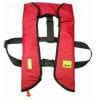 When they first came out, all the inflatable life jackets were manually inflatable. Although you can still purchase them, you have to be sure they say U.S. Coast Guard Approved. I have seen many that lack this wording and say something like SOLAS (Safety Of Life At Sea) Approved, or CE (European standard) Approved. They are usually much cheaper than the A/M models, but that monetary savings comes at a price: you have to be conscious to activate them in an emergency. That’s a big if, as people who fall or thrown overboard often are rendered unconscious. I do not recommend the manual only inflatable life jackets for the above reason.
When they first came out, all the inflatable life jackets were manually inflatable. Although you can still purchase them, you have to be sure they say U.S. Coast Guard Approved. I have seen many that lack this wording and say something like SOLAS (Safety Of Life At Sea) Approved, or CE (European standard) Approved. They are usually much cheaper than the A/M models, but that monetary savings comes at a price: you have to be conscious to activate them in an emergency. That’s a big if, as people who fall or thrown overboard often are rendered unconscious. I do not recommend the manual only inflatable life jackets for the above reason.
Darn Tootin’ I Like Fig Newton
There is a new standard in town for rating life jacket buoyancy: the Newton. You will soon see life jacket buoyancy rated in Newtons to harmonize with Canada, which uses the Newton as the European CE standard. Just as with the cookie of the same name, the more Newtons the better the buoyancy. Caution: Eating Fig Newtons may actually lower your buoyancy. Wait 30 minutes before any water activity after consuming Fig Newtons (Source: Mama). The Newton (N) is a measurement of energy force. Below is a table that gives you a rough comparison of Newtons to pounds of buoyancy. It is generally accepted that a life jacket with 150N will almost always turn an unconscious wearer face up in the water (yes, that is a good thing). Let’s look at the chart:

The top of the line hydrostatic A/M self-inflating life jackets typically have over 300N buoyancy. If I were to get one for Christmas I would be very happy.
Summary
Inflatable life jackets are great, but they are for adults only. They come in three basic designs: A/M, H, and M. I recommend the A/M and H type of life jacket because they do not require you to be conscious for them to work. A word of caution: most inflatable life jackets do not come with the CO2 cylinder installed. You must install it yourself when you get home. Another word of caution: when activated the bladder fills with CO2 forcefully. It is similar to a car air bag going off. For that reason, it is important for the life jacket to be properly worn and the waist buckle fastened. Leaving the waist buckle undone could result in injury or failure of the life jacket to function properly.
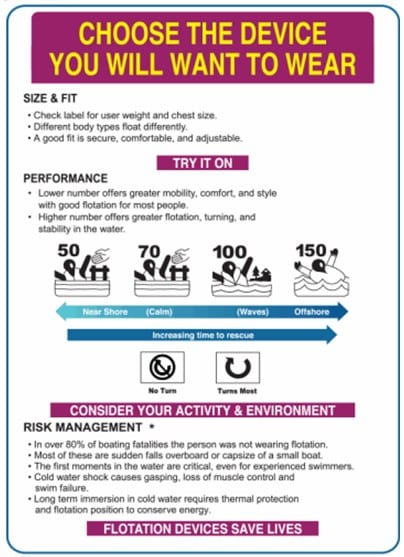
For more information on boating safety, please visit the Official Website of the U.S. Coast Guard’s Boating Safety Division at www.uscgboating.org. Questions about the US Coast Guard Auxiliary or our free Vessel Safety Check program may be directed to me at [email protected]. SAFE BOATING!
[Dec-1-2020]

 Posted in
Posted in 
























